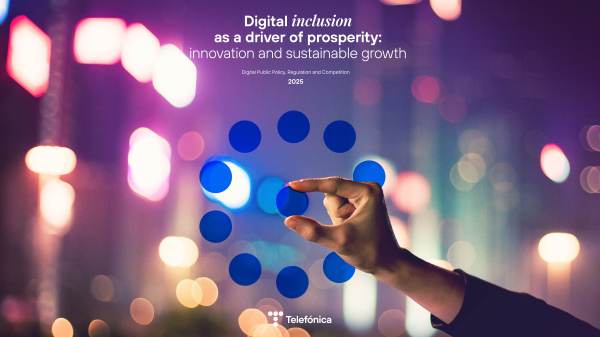Digital adoption could be summarised as that part of the digital transformation in which users have a sufficient level of competence to understand and therefore take full advantage of the benefits of digital tools.
Providing people with the skills, abilities and opportunities to not miss out on the advantages of the digital world is another step towards digital inclusion, in addition to the basic premise of facilitating and extending coverage in access to the Internet and digital solutions for those parts of the population that do not yet enjoy it.
The adoption of digital tools may be a challenge for people from different groups, but it serves to close the digital divide.
Precisely in terms of closing the digital divide, it should be pointed out that there are two different types of digital divide: the coverage divide and the usage divide.
In Telefónica’s position on the digital divide, the company offers a series of strategies and proposals to pave the way for digital adoption, as well as what to do to promote it.
Enabling digital adoption
In order to move towards digital adoption, it is necessary to identify potential barriers. Lack of digital literacy and skills, affordability of services and/or devices, or the availability of accessible content and services may be some of them.
Enabling digital adoption requires access to the Internet as the first prerequisite for integration into the digital age. To this end, four key levers can help address the usage gaps:
- Digital skills, which are essential to participate and develop in the digital age. Equipping all people with these skills regardless of their socio-economic status, age, gender or geographical origin is key to closing the digital divide.
- Affordability, both in terms of the possibility of accessing devices of sufficient quality for proper use and in terms of Internet access tariffs.
- Digital trust. Online fraud, scams and hacks are other issues that can lead to a lack of digital confidence that can lead to people who do not feel the need to learn about the digital world. For this reason, increasing security and privacy standards to put an end to this distrust is another important issue when moving towards digital adoption.
- Relevant digital content and services. The absence of relevant content for a variety of reasons – such as lack of adaptation, availability or diversity in digital content or services – makes it more difficult for unconnected households or individuals to have an interest in accessing the internet because they do not see potential benefits in doing so.
How to boost digital adoption
The operator also presents four different proposals to help boost digital adoption, linked to the four key levers we have just reviewed in the previous section.
Public-private collaboration
With the aim of achieving equal opportunities in access to the digital world, public-private partnerships can support the acceleration of digital literacy and skills through the incorporation of digital literacy into education systems or the promotion of lifelong learning to boost employability.
Affordable devices and access
Given that connectivity and the use of devices is essential, it is of great importance to provide mechanisms that make access to these devices or to the Internet affordable for society as a whole.
Accessible services and relevant content
The promotion of local content and services adapted to the different cultural realities of the different countries can be an incentive that, due to cultural proximity or proximity, can encourage people to approach new digital tools who would otherwise consider that they have no incentive to do so.
Similarly, ensuring accessibility for people who may have some kind of disability can also be a springboard towards the use of the possibilities offered by the digital age.
Trustworthy and accountable governance
Security or privacy are presented as attributes that must be linked to the digital society. Otherwise, if people perceive risks, the digital divide risks widening.
Prioritising training or taking into account highly vulnerable groups or communities should be another priority to be taken into account in order to achieve an inclusive digital future by harnessing the transformative potential of technology.
In the process of digitisation, one of the biggest challenges is therefore to achieve full digital inclusion. Check out our Compass.














